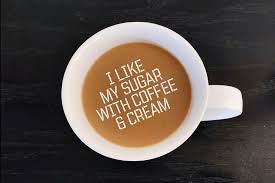The Many Aliases of Sugar
What is sugar?
Sugar is a simple carbohydrate that provides calories for the body to use as energy yet has no nutritional value. Sugar comes in two forms: naturally occurring and added or processed sugar.
What is the difference?
There is a big difference between natural and added sugars.
‘Naturally occurring sugars‘ refers to sugar naturally contained in dairy, fruits and vegetables and grains such as Lactose in milk and Fructose in fruits, Maltose in grains and Sucrose in many fruits and vegetables . These sugars, in their natural state, are combined with phytonutrients, fiber, vitamins and minerals that make them a complete nutritious package. Foods with natural sugar play a very important role in a healthy diet because they provide the essential nutrients the body needs for optimal health and wellness. Yet when these sugars are stripped from their original source and added as a sweetener to other food products they becomes simply empty calories.
Added sugar: At home we use granulated sugar or brown sugar in baked goods and in our coffee,  In factories sugar that is chemically produced, either high-fructose corn syrup, or sugar stripped from its original source, such as fructose, is used to add sweetness to food and beverages. And while we expect to find added sugars in the obvious foods such as soda, cakes, cookies ice cream etc. more sneaky and stealthily it is added to foods we don’t even consider sweet such as pretzels, bread, salad dressings pasta sauce , even frozen dinners and reduced fat peanut butter. In fact, 74% of all packaged food contains added sugar that does not supply any nutritional value, only added calories.
In factories sugar that is chemically produced, either high-fructose corn syrup, or sugar stripped from its original source, such as fructose, is used to add sweetness to food and beverages. And while we expect to find added sugars in the obvious foods such as soda, cakes, cookies ice cream etc. more sneaky and stealthily it is added to foods we don’t even consider sweet such as pretzels, bread, salad dressings pasta sauce , even frozen dinners and reduced fat peanut butter. In fact, 74% of all packaged food contains added sugar that does not supply any nutritional value, only added calories.
Trying to read the label on the products can make a person’s head spin, particularly if trying to determine the amount of added sugar.
Sugar can be listed under a variety of guises and often several types are used in a single product. And since food labels show the ingredients listed in descending order according to volume, the further down the list an ingredient appears the less of it there is in the food. By adding sugar in several different forms manufactures are able to add smaller amounts of each type giving the impression that the food contains less sugar than it does.(Yet when combined, these sugars can add up to be one of the most plentiful of all the ingredients). This is a handy, and perfectly legal if not entirely ethical, way to deceive consumers about the amount of added sugar contained in a product. This makes trying to figure out what percentage of calories these sugars represent in a packaged food product nearly impossible.
Currently, nutrition labels show the amount of sugar in a serving of food but make no distinction between sugars that naturally come with the territory, so to speak, such as the naturally occurring lactose in Yogurt and the sugar that is added along with fruit of other flavoring. Even being diligent about reading labels it is still hard to decipher how much added sugar we are consuming. The FDA has proposed a change in the nutrition label listing the amount of added sugar in foods. This will help us all to be more informed consumers. However until these changes take place, up to 2 years from now, we will need to be our own detectives by looking for hidden sources of sugars in the ingredients list.
While this is not an exhaustive list; some of the many aliases of sugar to look for:
Besides words ending in “ose” such as glucose, fructose, maltose, and dextrose, be on the lookout for cane juice or cane syrup, corn sweeteners and high-fructose corn syrup, fruit juice concentrates and nectars, honey, malt syrup, molasses, and agave, Maltodextrin, and Brown Rice Syrup.
The health issues – why is added sugar a problem?
Metabolism matter: The body reacts to the two types of sugar quite differently. While the body breaks down the refined sugar very rapidly, causing the blood sugar and insulin levels to skyrocket, Thanks to the protein in the milk and the fiber in the fruit vegetables and grains the body metabolizes the sugar contained in whole foods much more slowly. This is the key to maintaining normal blood sugar levels and a longer feeling of satiety.
Weight gain: When large doses of added sugar are consumed, the sugar overwhelms the liver’s ability to metabolize sugar. The liver responds by doing the most efficient thing it can do with sugar, it converts it to fat, which overtime leads to metabolic syndrome by contributing to:
– Fatty liver disease
– Increased triglycerides
– Liver insulin resistance
– Increased small, dense LDL cholesterol
– Increased uric acid, which contributes to hypertension
Excess sugar and Blood Pressure: sugar may be worse for your blood pressure than salt. Several studies show that added sugar may increase blood pressure and blood pressure variability, increase heart rate and myocardial oxygen demand, contribute to inflammation, insulin resistance and disruption of normal metabolic function. Recent studies show added sugars having a greater role than salt in causing high blood pressure and heart diseases.
Aging skin: if the promise of a healthier heart, better metabolism and slimmer figure has not curbed your appetite for the sweet stuff, perhaps the quest for younger looking skin will. It is a bitter pill to swallow, but experts now believe that consistent over-consumption of excess sugar contributes to premature skin aging. Sugar in the bloodstream attaches to proteins which then become Advanced Glycation End Products or AGEs These AGEs cause the breakdown of collagen and elastin which are responsible for keeping our skin firm and avoid sagging and wrinkles. More sugar in our diet equals more AGEs to cause havoc. These accumulating AGEs also shut down your body´s natural protective enzymes making you more susceptible to the damaging rays of the sun, the main driver of skin aging.
So why is so much sugar used?
Several reasons. First and foremost because of the taste. Sugar can make cheap ingredients taste better. Sugar can also be used as a preservative. Along with other ingredients it can improve moisture retention, keeping donuts, bread and cakes softer for longer.
Yet our knowledge of the health problems that too much sugar causes continues to mount. From diabetes to obesity, to gout and heart diseases even premature aging: the list seems to be growing every day.
Many experts say it even might be addictive.
“There is an increasing body of research demonstrating that sugar can stimulate the brain’s reward-processing center in a manner that mimics what we see with some recreational drugs. In certain individuals with certain predispositions, this could manifest as an addiction to sugary foods. “ Andy Bellatti, MS, RD
“Evidence is mounting that too much added sugar could lead to true addiction. Added sugar is not the sugar naturally found in foods, but the amped up levels added to many processed foods. Medical addiction changes brain chemistry to cause binging, craving, withdrawal symptoms, and sensitization. Excess added sugar can do just that, through changes in the same pathways as addiction to amphetamines or alcohol.“ Alan Greene, MD
“Research shows that sugar can be even more addicting than cocaine. Sugar activates the opiate receptors in our brain and affects the reward center, which leads to compulsive behavior, despite the negative consequences like weight gain, headaches, hormone imbalances, and more. Studies suggest that every time we eat sweets we are reinforcing those neuropathways causing the brain to become increasingly hardwired to crave sugar, building up a tolerance like any other drug. It also provokes similar withdrawal symptoms once you’re hooked.“ Cassie Bjork, RD, LD
It seems we just cannot get enough this sweet stuff and the sad truth is that manufacturers know it. A careful look of the food labels and knowing what are you looking for are the strongest tools you have in order to control your sugar intake.
Have questions about nutrition? I’m here to help. Call today to schedule a consultation or to learn more about what 2BFit can do for you.
Look Good Feel Good Live Better!
Stacia
